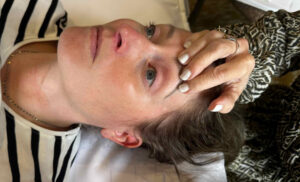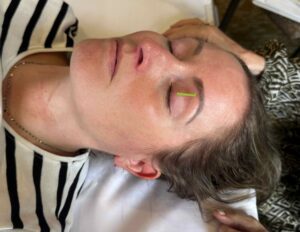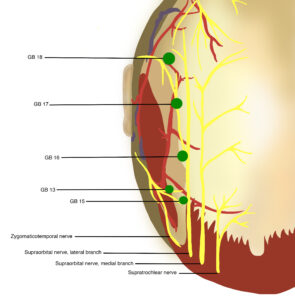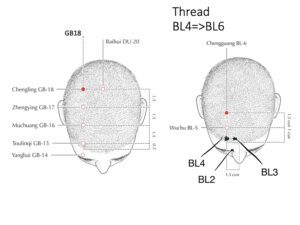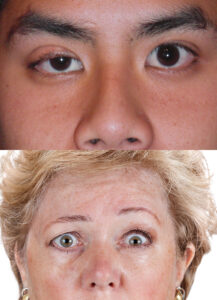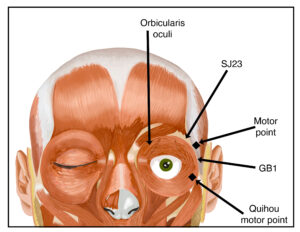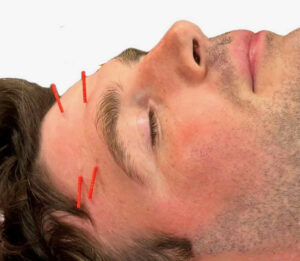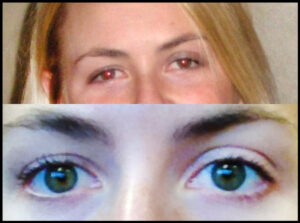I recently received a question in my Facebook group, “facial acupuncture,” regarding drooping eyelids caused by congenital ptosis. To answer the question, I pulled from these two chapters in my upcoming book: Treating the Face: a Manual for Acupuncturists and Allied Health Professions-Copyright 2024-Michelle Gellis AP. If you are interested in being on the waitlist for the book, you can sign up on my website to be on my mailing list.
Figure 4.19 Hooded Eyelids
Hooded Eyelids-(From Chapter 4-Cosmetic Acupuncture)
Figure 4.20 a,b,c
Needling Technique for Hooded Eyelids
If your patient has hooded eyelids or if their eyebrows begin to move downward (even migrating below the orbital rim), needle BL-2, Yuyao, and TH-23. Needle Yuyao in line with the center of the pupil, instead of landmarking the center of the eyebrow. These three points are needled with a 15 mm × 0.14 mm needle pointed upward to lift the brow. By needling the levator muscle, you are giving the whole brow area a lift. With your non-needling hand, lift the brow above the level of the orbital rim (Figure 4.20a) and needle under the brow (Figure 4.20b) straight up almost to the handle(Figure 4.20c).
GB-18 is a mandatory point. It has a direct action on the supraorbital nerve (CN VI) and the galea aponeurotica (which links the occipital and frontal bellies of the occipitofrontalis muscle). GB-18 is located on the scalp, directly lateral to DU-20, in line with the center of the eyebrow (Figure 4.21).
Figure 4.21 GB-18
Another point I use for lifting the brows is BL-6 (Figure 4.22). I thread a needle along the scalp from BL-4 to BL-6 with a 0.5- to 1.0-cun needle.
Figure 4.22 BL-4 to BL-6 and GB-18 side by side25
Ptosis (from Chapter 6-Treating Neuromuscular Facial Conditions)
Eye ptosis occurs when the levator and superior tarsal muscles that raise the eyelid are not strong enough. As a result, one or both eyelids can droop. In our treatment rooms, we typically see patients with some disparity between one eyelid and the other. It can happen as we get older, but some people are born with congenital ptosis. Common causes of congenital ptosis remain unknown.
People with ptosis tolerate it to some extent, but when it becomes noticeable, they may contact us for treatment. It is more common in older adults as the muscles in the eyelids begin to deteriorate. Ptosis can be a problem for someone with Bell’s palsy, MS, or stroke. For some, it may be their sole symptom.
A person may have ptosis because they have sagging skin on their eyelids rather than muscle weakness. Many of my cosmetic patients come for acupuncture because their eyelids are drooping, and they want help to raise them. For these patients, I use local treatments outlined in my cosmetic treatment in Chapter 4.
Etiology
Ptosis may be caused by trauma to the muscles that raise the eyelid (Figure 6.9). It can also be due to damage of the superior cervical sympathetic ganglion or damage to CN III (oculomotor nerve) that controls the muscles that raise the eyelid. Such damage could be a sign or symptom of an underlying disease, such as diabetes mellitus or a brain tumor, or diseases that can cause muscle weakness or nerve damage, such as myasthenia gravis.
Another cause of ptosis is Horner’s syndrome, a form of nerve damage that occurs in the face and eyes, usually the result of an underlying condition such as injury to the neck or a tumor, stroke, other brain injuries, or a spinal cord injury. Some forms of Lung cancer can cause Horner’s syndrome and ptosis. Cluster headaches can also cause ptosis in certain individuals. These severe headaches strike in a frequent pattern for some time (cluster periods) and then go into remission.
When you see ptosis in your treatment room, your patient should have it diagnosed by a medical doctor first to ensure that nothing else is going on. Some causes of ptosis are benign; others are very serious.
Figure 6.9 Photos of Ptosis
According to the CM theory, ptosis of the upper eyelid is due to a congenital deficiency, a deficiency of the Spleen and Kidney, or an obstruction of the collaterals by wind phlegm, all of which lead to malnourishment of the upper eyelid.
In CM, ptosis of the upper eyelid is generally divided into two types: Spleen and Kidney deficiency and Spleen deficiency with wind phlegm. Points of the Stomach, bladder, and Spleen channels are frequently selected for treatment.
Spleen and Kidney Deficiency
Signs and Symptoms
- Ptosis of bilateral upper eyelids, soreness, and weakness of the lower back and knees, poor appetite, loose stools
- Tongue: Pale body with white coating
- Pulse: Deep and weak
Treatment principle: Reinforce the Spleen and warm the Kidney.
Figure 6.10 Needling points for ptosis
Treatment Points
- GB-14, BL-2, Yuyao, TH-23 (Figure 6.10)
- Promotes nourishment of the upper eyelid and strengthen the local muscles.
- Note: When needling Yuyao, needle under the eyebrow, taking care not to needle into the lid. Pull the brow up above the brow bone and glide the needle under the brow with a 0.5-mm needle. (Figure 6.10)
GV-20: Reinforces qi, raise yang, and lift sunken qi.
Note: In addition to GV-20, I use GB-18, an eye reflex point.
- ST-36: Reinforces qi, raise yang, and lift sunken qi.
- SP-6: Reinforces the Spleen and tonify qi.
- KI-7: Warms Kidney yang.
- Optional additions:
- BL-20: Reinforces the Spleen and tonifies qi. Tonify and use moxa.
- BL-23: Warms Kidney yang. Tonify and use moxa.
- GB-15: Local point
- Thread BL-4 posterior to BL-6 (Figure 6.11).
Spleen Deficiency with Wind-Phlegm
Signs and Symptoms
- Ptosis, swelling, and numbness of the upper eyelid, difficulty moving eyeball, numbness of the limbs, fatigue, poor appetite.
- Tongue: Pale body with white and sticky coating
- Pulse: Soft and thready
Treatment principle: Reinforce the Spleen and resolve phlegm.
Primary Points
- GB-14: Promotes nourishment of the upper lid and strengthens the local muscles (gently manipulate)
- BL-2, Yuyao, GV-20, TH-23 (gently manipulate): local points
- ST-3: Reinforce the ST qi.
- SP-9, SP-3: Reinforce the Spleen and remove dampness
- ST-40: Transform phlegm
Additional points:
- BL-2 and TH-23: Needled upward.
- BL-4: Threaded toward BL-6
- GB-18: Eye reflex point
Other important considerations are as follows:
- Scalp acupuncture: Scalp motor point (lower two fifths) on the opposite side of symptoms. If you are not getting proper effect, you can needle both sides.
- Ear acupuncture: Ear Shen Men
Motor points
- Needle the two motor points affecting the orbicularis oculi (Figure 6.12): extra point Qiuhou and TH-23. Quihou is located approximately halfway between GB-1 and TH-23. Both points are needled with oblique insertion 0.2–0.3 cun.
- You can also needle the motor point for the frontalis, which raises eyebrows. The motor point is GB-14 and needled obliquely 0.3–0.5 cun.
Figure 6.12 Motor Points for Orbicularis Oculi
Figure 6.13 Submuscular Needling of the frontalis muscle.
- Submuscular needling: Submuscular needling of the frontalis muscles is helpful. (Figure 6.13)
- Facial cupping and Gua sha: Attention to the forehead and temples, as well as moving all around the orbicularis oculi. If you point the cup away from the eyeball, you can cup gently inside the orbital rim.
- Derma rolling: On the face and over affected areas, staying outside of the orbital rim.
Case Study
Figure 6.14 Patient Before and After Ptosis Treatment
Figure 6.14 shows before-and-after pictures of a patient with uneven eyelids. She was concerned about her wedding pictures capturing the asymmetry. During our conversation, she mentioned wearing a sleep mask to bed. I had read that conventional sleep masks can weaken the eyelid muscles, so I suggested she stop wearing it. Because she had served in the military and often had to sleep during the day, she lacked proper curtains in her bedroom. I advised her to opt for room-darkening curtains instead of a sleep mask.
Considering her upcoming wedding stress, she began seeing me a few weeks before the ceremony because her right eyelid was sagging due to congenital ptosis. She reported consistently getting less than seven hours of sleep per night, often feeling tired even after a whole night’s rest. She was also attending acupuncture school and participating in an herb program that required a long daily commute.
Treatment focused on addressing the Kidney level and targeted ptosis with specific points like Yuyao, BL-2, TH-23, GB-14, 15, BL-4 threaded to BL-6 and GB-18. I also advised her to stop wearing a sleep mask to prevent further weakening of the levator muscle. I diagnosed her with KI yin deficiency and treated her constitutionally by targeting yin tang and HT/KI points to address sleep deprivation and anxiety. After local and constitutional treatment, her eyelids became more symmetrical, with a slight lift of the brow on the right side, making the eyelid more noticeable.



